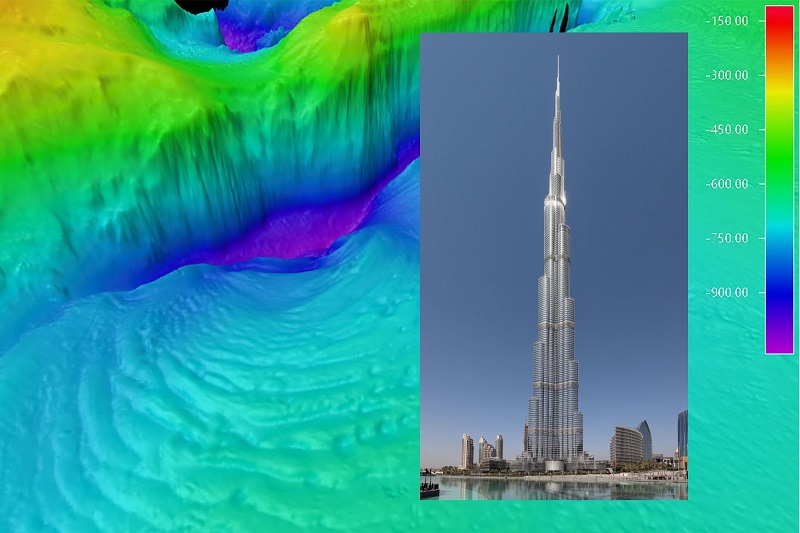ISABEL RUBIO ARROYO | Tungsteno
Only 5% of the ocean has been explored and mapped by humans, according to UNESCO. An autonomous ocean mapping vehicle has identified a previously unidentified seamount that is larger than the tallest building on Earth. These geological formations could serve as a reference point for different habitats and the search for previously unknown life. What is known about this mysterious mountain, taller than the Burj Khalifa?
A giant mountain hidden under the sea
The vehicle in question is called the Saildrone Surveyor, and it has spent several months surveying Alaska's Aleutian Islands and areas off the coast of California. In total, it has surveyed more than 45,000 square kilometres of ocean floor, even in 35-knot winds and waves of more than five metres. These conditions would have been "too challenging for most crewed survey vessels," according to Saildrone.
One of the most striking findings is a previously unknown seamount off the coast of California that is around 1,000 metres high. This underwater mountain is therefore taller than the world's tallest skyscraper, the Burj Khalifa in Dubai. At over 828 metres tall and 160 storeys, the structure holds several world records. As well as being the tallest building on the planet, it has the world's highest open-air observation deck and the elevator with the longest travel distance in the world.
The Saildrone Surveyor is the world´s largest uncrewed ocean mapping vehicle. Credit: Saildrone
An unexplored seafloor
"Identifying such seamounts improves our understanding of the physical processes of the ocean and identifies areas needing further exploration as unique habitats," says Saildrone. The US Exclusive Economic Zone (EEZ), which extends from the coast to 200 nautical miles from the shore, is one of the largest in the world, but much of it remains unmapped, unobserved and unexplored. "In terms of area, Alaska is by far the least mapped region of the US EEZ," says Saildrone.
Aurora Elmore, Cooperative Institute Manager at National Oceanic and Atmospheric Administration (NOAA) Ocean Exploration, says that every American, in one way or the other, depends on the ocean: "From protein from fish to feed animals or humans, to deep-sea cables that make the Internet possible. The only way the US can maximise our ocean resources is to understand what's there," she says.
During the mission, the Surveyor also carried technology from the Monterey Bay Aquarium Research Institute (MBARI) to collect environmental DNA. "Outfitted with the Environmental Sample Processor, a groundbreaking "lab in a can," the Surveyor was able to collect important clues about marine biodiversity and ocean health from the genetic "fingerprints" left behind by marine life," says Saildrone. But no specific details are offered.
The Surveyor aims to unlock the deepest secrets of the ocean. Credit: Saildrone.
Unique ecosystems on the ocean floor
The Saildrone Surveyor mission is funded by NOAA and the Bureau of Ocean Energy Management. It is the first step in mapping the seafloor of key regions in Aleutian waters at high resolution. Elmore says the advantage of the Surveyor "is getting that initial exploration step done faster, cheaper, and without as much staff."
But Saildrone is not the only project of its kind. The crew of the Schmidt Ocean Institute's research vessel Falkor (too) is also trying to unravel the mystery of the ocean floor, and has discovered several giant seamounts. "A map is a fundamental tool for understanding our planeta”locating seamounts almost always leads us to understudied biodiversity hotspots," says Jyotika Virmani, Executive Director of Schmidt Ocean Institute. "Each time we find these bustling seafloor communities, we make incredible new discoveries and advance our knowledge of life on Earth," she says.
Seamounts can host biodiversity hotspots. Credit: Schmidt Ocean Institute.
Many details about the seamounts are still unknown. But their discovery raises many questions: from how they were formed, to what kind of marine life lives on them, how they impact ocean currents, and even whether they could be a source of mineral resources. As Jamie McMichael-Phillips, project director of Seabed 2030, points out, "with 75% of the ocean still to be mapped, there is so much to be uncovered. Ocean mapping is crucial to our understanding of the planet and, in turn, our ability to ensure its protection and sustainable management."
Tungsteno is a journalism laboratory to scan the essence of innovation.
